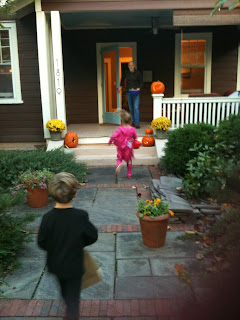A site called MetaFilter recently posted the following question, “Calling all non-USAans: Can you give me some examples of tiny, weird things you discovered about the United States only when you got here?” The responses cover many aspects of America life and are a lot of fun to read. Sandwiched in with observations about bottomless cups of coffee, guns at Walmart, the diversity of choice in toothpaste, and the amount of water in our toilets, I found some useful reflections on our transportation system. The following is a compilation of these observations, organized by topic. The list is unedited so I apologize in advance for the occasional curse word.
Pedestrian Accommodations
- Drive-through everythings. Drive-through ATMs, drive-through bank tellers, drive-through pharmacies, drive-through liquor stores in some states. On the flipside, the paucity of sidewalks/pavements in many parts of the US, where your European would receive funny looks from his hosts if he suggested walking to a relatively nearby destination, and might even be stopped by the cops if they spotted him strolling along a residential area.
- Residential streets without sidewalks.
- The first time I tried to cross a road by myself, it took me at least 15 minutes to get the rhythm of the traffic lights and how much time I had to make it to the other side. Streets are a lot wider, so the timing is completely different. And the multi-lane intersections... aaah. So confusing.
- Jaywalking - seriously - you're going to ticket me for crossing the road?
Signs and Markings
- Writing on the road is the wrong way around: LANE BIKE not BIKE LANE.
- Oh, and the round things that mark highway lanes. Someone told me that the guy who invented them licensed them to the Dept of Hwys for 10c each. Whenever I go to the US, I try to count them and estimate his riches.
- From the UK: much greater tendency to use text on signs - in Europe we tend either to use graphics or not to bother with a sign at all.
Intersections and Right of Way
- Some places you can turn right on red -- wait what YOU CAN DRIVE THROUGH A RED LIGHT if you're turning WHAT THE HELL PEOPLE
- No roundabouts. Stop signs and the awkward negotiated dance of who has the right-of-way to go next.
- Four-way stops flummoxed me. As a UK driver I'm used to roundabouts where you know who has right of way. Working out who has right of way at a four-way stop is a recipe for an accident. (In Ohio, it appears, the truck with the biggest tyres tires has right of way.)
Freeways and Speed
- Speed limits that feel way too slow -- 35 limits would often be 45 or 50 or 60 back home. Freeway exits sometimes every quarter-mile -- UK motorways have very much fewer exits.
- The roads are just huge. A dual carriageway/divided highway is a big road in the UK, but it's every other street in Texas. Never have I seen so many huge, multi-level junctions
City Planning
- Cities where streets follow a grid. And almost all streets allow cars. As a European I'm accustomed to look for the city center; a place where there are no cars, where streets are meandering, where there are terraces to sit outside and have a coffee. A place that's amenable to walking, to hanging out and enjoying the atmosphere. I did not find such a space in the american cities I've been to. And it prevented me from enjoying the place.
- There isn't a pedestrian area in city centers where you can stroll between shops and cafes and not worry about getting run over by a bus.
- Lots of things that people have said above, but the thing that amazed me the most was going to places, large places, that have no center. If you want a funny look, stop someone in Boca Raton and ask them where the main street is.
- Lack of sidewalks, even within large shopping malls (I have to drive in from the street? I have to DRIVE between buildings in the same complex?!)
Bicycling
- Riding a bike is dangerous and an enterprise, not a mindless means of transport.
Transit
- The buses in LA make a stop every block. During a one-hour bus trip, the bus might make 66 stops. That is more than a stop a minute.
- We were surprised to find that our neighbors had not only never used the bus, but they were scared to! This kind of attitude seems to lead to a viscous funding cycle for transit. In fact, people vote against upgrades to transit, because it might bring the riffraff into their neighborhood.
Vehicles and Parking Lots
- The cars here are huge! I've stood eye-to-eye with a bumper.
- And oh man the surbuban parking lots! Yeah everyone's heard of them, but nothing will prepare you for the overwhelming size and quantity.
- Stores have their own parking lot and you cannot run errands in medium towns without driving between different shops.
The responses illuminate a lot of areas for improvement in the U.S. However, having traveled abroad extensively, America doesn’t have a corner on the transportation quirks market. Many countries need to work on their pedestrian facilities, rural roads, and vehicle interactions at intersections. I almost fell through a hole on a bridge in Russia, took my life into my hands crossing a roundabout in Paris, and ran over a sheep’s leg in Ireland. Nobody’s perfect.
If you have a transportation quirk to share, either from your experiences in the U.S. or your travels abroad, please post a comment.



